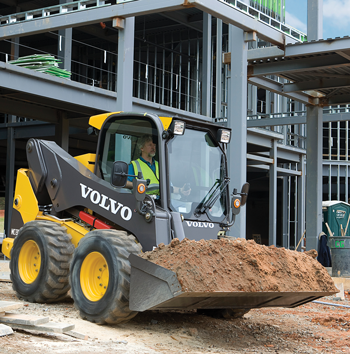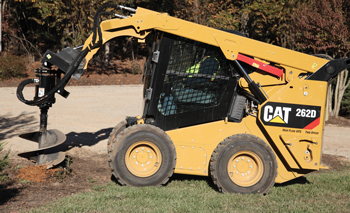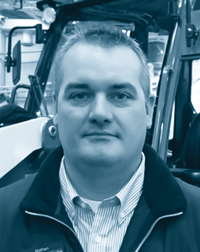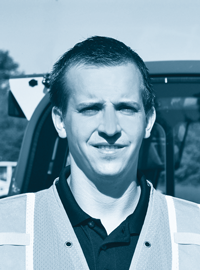Industry Outlook:
Skid-steer loaders
 |
| Skid-steer loaders provide a versatile yet less costly way to move material and complete jobs. |
Skid-steer loaders provide a versatile yet less costly way to move material and complete jobs.
Industry experts share how skid-steer loaders are evolving to continue meeting the ever-changing needs of end users.
 |
| Jason Archbold marketing manager, Bobcat Co. |
Make the right match
One of the biggest challenges end users and rental centers face with skid-steer loaders is matching the model to the job. Manufacturers offer skid-steer loaders in various sizes and many configurations for engine horsepower, auxiliary hydraulic flow and operating capacity.
Will the unit be used to lift heavy, dense sand, soil or gravel? Will it be loading and unloading pallets and what is the weight of those palletized materials? If the material being moved is lighter, loose materials, lifting performance may be less of an issue.
Attachments expand skid-steer versatility, however, hydraulic breakers or hydraulic clamps require more auxiliary hydraulic flow vs. non-hydraulic attachments like a bucket or pallet fork.
Visibility from inside the cab has changed significantly over time. Today’s skid-steer loader design puts operators closer to the work area with better attachment visibility plus improved visibility all around the machine. Improved visibility reduces the risk of hitting objects and reduces the potential for downtime.
Ease of maintenance is a big part of how skid-steer loaders are evolving. We will continue to see improvements in machine design for easier access and intuitive layout to maintenance checkpoints. This helps prevent unnecessary wear and tear on a machine and minimizes the work that needs to be done to a machine once it is returned. The key is to ensure rental stores take time to show customers what maintenance should be done while the machine is out on rent. A short overview of the skid-steer loader and routine maintenance checkpoints can save unnecessary downtime later.
Skid-steer loaders should be offered for rent with a variety of attachments, which can enhance rentals year-round. Augers and hydraulic breakers are two of the most popular attachments for construction contractors, some manufacturers offer more than 70 attachments for compact equipment that can create distinct advantages in today’s competitive rental market.
While customer rental needs for a skid-steer loader vary, a machine outfitted with an attachment is typically designated for a specific purpose. Attachment versatility can stretch skid-steer loader capabilities because it helps users adjust to changing applications and allows units to perform multiple jobs. This may keep a machine on a job site longer, thus boosting the rental revenue.
John Dotto, brand marketing manager, Case Construction Equipment:
Options abound, creating rental challenges
One of the challenges that rental centers face today with skid steer loaders is the number of choices that are available — the different ways the machine can be configured and also the decision to choose a particular operating style over another.
Rental centers are increasingly going to electro-hydraulic machines that allow controls to switch between ISO- and H-control patterns. That level of technology requires more sophistication from a technical standpoint when it comes to troubleshooting issues, but these machines appeal to a broader range of end users.
Effective skid-steer loader use can depend on the weather and other factors. A rental house may have a customer who is hesitant to rent a skid-steer loader because a rainy forecast may affect how many days he’s going to be able to use that skid-steer loader, and may be more interested in a compact track loader because it can operate in adverse conditions.
Tier 4 Final-compliant machines cause some issues for renters and rental centers. Slowly, the rental customer base is learning to operate Tier 4 Final-compliant machines. As rental centers get more Tier 4 Final- engines and aftertreatment solutions into their rental fleets, they must educate the end user who may not be familiar with how Tier 4 Final technologies work.Otherwise, it’s likely the end user will experience downtime and will be calling for repair assistance.
Because of the broad range of options available on skid-steer loaders from many manufacturers, the rental house is faced with the challenge of how to best spec the machine. Do they go bare bones for the highest return on investment? Do they choose a few more features to improve the loader’s value as it enters its secondary market life?
The Case skid steer line has continually evolved to provide industry-leading breakout forces, improved torque and hydraulic flow, all of which make them more appealing to end users. EZ-EH controls allow operators to switch between personalized speed and control settings and allows programming of up to nine different operator presets at the touch of a button. Optional Ride Control automatically controls loader arm bounce, which reduces machine wear and keeps more material in the bucket.
Having a 100 percent high-hydraulic flow fleet would raise fleet costs and exposes the potential for low utilization, so it doesn’t make sense. However, having a few high-flow systems in the fleet to accommodate some of high-flow attachments needs can improve rental rates and use.
Rental houses can differentiate a high-flow system from a standard-flow system. Consider developing a high-flow daily, weekly, or monthly rate that’s at a premium price vs. a standard configuration. It opens the potential to get more income from the high-flow unit, assuming that a customer may also potentially rent a high-flow attachment with it.
 |
| Jeff Brown, skid-steer market professional, Caterpillar |
Productivity improvements
For rental centers, skid-steer loader fleet utilization and equipment maintenance and repair costs are key.
To meet the maintenance and repair challenge, rental centers are increasingly looking to telematics to remotely monitor equipment health. Basic telematics are being deployed widely to track hours and asset location. For instance, all Caterpillar products come standard with hour and location reporting capability. Knowing exact machine hours enables the rental center to stay on top of scheduled maintenance, which helps keep repair costs in check.
New technology is also assisting rental centers in equipment security. For example, Cat skid-steer loaders and other models equipped with the Advanced Display allow rental end users to use the coded start system, which helps with equipment security on a job site and allows managers to track hour usage and fuel burn across multiple users. If one operator is burning more fuel than others, the system will catch that and provide an opportunity for training better operating techniques. This can help end users control operating costs.
 |
| Attachments are increasing the versatility of skid-steer loaders. |
Increasingly, users are wanting skid-steer loaders with specific attachments and there are a growing variety of attachments available. Many are easy to use even by novice operators. Using hydraulically driven attachments requires finesse, but operators can use continuous flow and creep speed to set the tool and machine in “cruise control mode,” allowing them to focus on completing a quality job.
The growing popularity of rear-view cameras helps with operator safety. It is integrated into the existing machine display and provides excellent visibility to objects behind the machine. This view gives operators more confidence, allowing them to work faster.
 |
| Randy Tinley, skid-steer and compact track loader product manager |
Trends toward versatility
Rental centers and end users are concerned with transportation regulations, which is primarily an issue of machine weight. The weight of the skid-steer loader and attachments will determine whether the machine can be towed or whether costlier alternative transportation is needed.
Today’s skid-steer loaders are becoming lighter, faster and more capable. Ultimately, this allows rental houses to offer increasing versatility and capability to end users. When end users can complete a wider range of jobs using a skid-steer loader instead of a compact track loader, rental centers do not need to maintain a more complex track loader fleet.
Advanced Electronic Controls have been a game changer. A customer can now select a control pattern with which they are familiar so they can get right to work.
A growing selection of attachments, combined with a universal quick hitch, means that skid-steer loader renters can use the right tool for the job, so they can complete tasks more efficiently and safely. That equals profit for end users and rental centers.
Fuel-efficient engines with less complex maintenance programs because they don’t use a diesel particulate filter (DPF) and diesel exhaust fluid (DEF) to meet Tier 4 Final regulations makes the rental experience less onerous and maximizes the time the machine can be working to the job.
 |
| Gregg Zupancic, product marketing maanger, John Deere |
Attachments drive skid-steer popularity
One of the biggest challenges rental centers face today is possessing inventory that meets the needs of a variety of customers who tend to have vastly different application plans. A full line of popular attachments adds value to each unit, and allows rental centers to charge higher fees.
Rental centers should have at least a bucket, pallet forks and broom attachment in their lineup because they are the most commonly used attachments by key rental groups.
Our user research has led us to the development of having the skid-steer loader cab easily roll back to provide quick access to the engine compartment. All fluids are color coded to avoid maintenance mishaps and the operator has easy access to panels to quickly clean away dirt and debris. John Deere skid steer loaders have a boom lock to ensure the service person can lock the boom up safely.
To meet the risk avoidance demands from rental center owners, John Deere engineers are putting more technology into its skid steer loaders to give rental centers more control over their machines after they leave the lot. For example, John Deere skid-steer loaders have a two-speed option that allows the machine owner to adjust maximum travel speed from 12 mph to 7 mph. This allows rental centers to limit machine speeds for inexperienced customers whose applications don’t require higher speeds.
Another risk-mitigating feature is auto shutdown. If the engine or any of the major fluids run low or overheats, this system will detect the problem and automatically shut down the skid-steer loader.
Rental centers are investing in features that make skid steers loaders more marketable to a variety of customers. Flexible control choices on our G-Series models allow contractors to choose between standard foot and hand controls, optional hands-only controls or enhanced (EH) joystick controls that are switchable between ISO- and H-patterns.
John Deere offers more than 100 WorkSite Pro attachments to meet the needs of all rental segments. No other skid-steer manufacturer has introduced more attachments to the industry in the past few years than John Deere and that will continue.
 |
| Jorge De Hoyas,senior product manager, skid steers and track loaders |
Selection key to skid-steer loader rentability
Versatility of controls, having the right configuration and having a trouble-free machine that can withstand heavy-duty use are constant challenges rental centers face. Some renters may prefer the hand and foot controls, others ISO-pilot controls, and still others may prefer H-pattern controls. Rental centers that can provide a wide selection of controls can have a competitive advantage.
Rental centers are finding they can charge a premium for configurations that include air-conditioned cabs, but they also find keeping cabs in good condition can be challenging. Identifying machines that are nearly indestructible with heavy-duty doors and reliable engines like those found on the Kubota skid steer loaders helps in their quest for dependability.
Kubota skid steer loaders offer a roll-up door that allows it to be locked open so operators don’t need to remove and store the door. Another unique feature of Kubota skid-steer loaders is the rear door-mounted fuel tank. The fuel tank is protected by the solid, heavy-duty door and an additional inch of void between them. This takes the tank out of the engine compartment, freeing space that makes daily maintenance easier to do.
Telematics is no longer just reserved for large fleet owners. Rental centers are realizing cost of ownership savings from locating equipment and remote-monitoring performance.
Hydraulic and non-hydraulic attachments continue to grow and Kubota’s recent introduction of attachments are a multiplier in the workforce. Rental centers are investing more in attachments for skid steer loaders and compact track loaders, which helps minimize purchases of other dedicated equipment.
 |
| Nathan Ryan, skid-steer global product manager, Manitou Americas |
Skid-steer loaders, track loaders go together
Many renters are looking for skid-steer loader comfort and control improvements to help them retain skilled workers. Better ergonomics, a more comfortable seat and a radio help improve the operator’s job satisfaction.
Rental centers that offer attachments usually see better returns on their investments. Stump grinders, augers and brooms turn these versatile material movers into tools that offer renters a low-cost option for equipment they don’t require frequently. The rental center may price the attachment separately or package it with the base rental as a perq.
While compact track loaders are invading the rental market, skid-steer loaders still offer several advantages. Rental centers with snow removal rental opportunities can attest to the speed and traction of skid-steer loaders. With the machine’s small size, it’s a perfect tool to clear snow from small to medium parking lots and drives.
Skid-steer loaders are a low-cost alternative to compact track loaders and offer a less-expensive option to fulfill rental demands. An adequate mix of skid-steer loaders and compact track loaders can balance fleet cost and performance requirements
Alex Berg, president/CEO, Triple E Equipment
Electric skid steers open rental options
Rental customers are increasingly looking for options that can help customers complete inside renovation and excavation jobs. Just as it took a while for mini excavators to become mainstream on job sites, small, electric skid-steer loaders are on the same path of acceptance.
These lead-acid battery models can fit through doorways and be moved by elevator for inside demolition or renovation work.
These models, which are generally less than 2,000 pounds operating weight, usually have a stand-up or walk-behind cab and can work in extremely tight, enclosed work areas. Being 100 percent battery-powered, the units can operate where exhaust fumes are prohibited.
The models can operate seven or eight hours between charges and usually users find they can get two days of work from a single charge. It recharges via 110-volt power overnight. The electric models run smoothly and quietly, without the shake, noise, rattle and fumes found with engine-powered models.
Sales for these types of skid-steer loaders have doubled every year since they were introduced in the United States four years ago. They are gaining popularity with rental centers as a specialty machine, especially in metropolitan areas.
 |
| Kevin Scotese, product manager, Volvo Construction Equipment |
Larger units open options
With skid-steer loaders, transportability is a major consideration for rental houses and customers. Machines that weigh more than 10,000 pounds require a commercial driver’s license (CDL) to transport and that is why the relatively low weight of skid-steer loaders is part of the reason why they are so popular in rental; they are light enough to transport without a CDL. Volvo offers a full line of Volvo skid steers under 10,000 pounds, which can be transported without a CDL requirement, in most cases.
Theft and vandalism are huge concerns with rental units. Selecting a base-model skid-steer loader with no glass, canopy and fewer lights help deters vandalism. Rental houses can also use telematics to set up a geo-fence to help prevent theft.
The trend toward larger models is one of biggest changes in skid steer loader design over the last decade. These larger models may make a customer consider renting a skid-steer loader over a compact wheel loader or backhoe loader because of the skid steer’s increased power, lift capacity and lift height. Increased hydraulic flow allows use of a wider range of attachments and boom suspension and ride control allow faster travel on rough terrain while spilling less from the bucket.
As skid-steer loader have gotten larger, so have their cabs, featuring creature comforts typically associated with larger machines, including back-up cameras, HVAC, radio, and Bluetooth.
Side-door entry is a popular design differentiator with contractors wanting to rent a skid-steer loader. Volvo skid-steer loaders allow the operator to safely and easily enter and exit from the side, regardless of where the arm is positioned or what attachment is on the machine.
The parallel lift-and-raise feature that comes standard on all Volvo skid steer loaders is especially appealing for applications requiring forks because it keeps the load parallel to the ground so the load is more secure throughout the lifting cycle.









